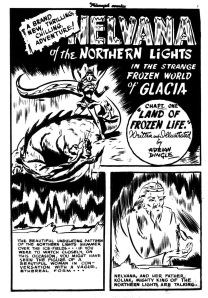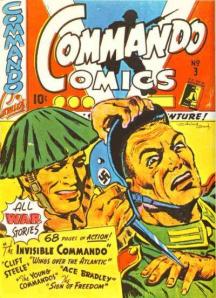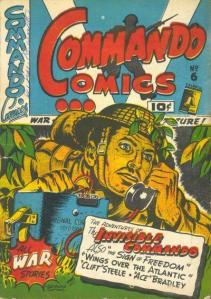On September 10th, 1939 Canada joined the war effort and made its first independent declaration of war. It maintained its status and position in the war effort but by late 1940, preservation of the Canadian dollar became a priority. In December of 1940 the legislation known as the War Exchange Conservation Act (WECA) was passed and the prohibition of importing luxury goods from outside Canada commenced.
Also during this time, the American pulps and comics industry was booming. Some of the most famous current superheroes were well into their own story lines, and children in North America were reading them religiously. However, with the introduction of WECA, American comics were quickly removed from Canadian new stands as they fell under the non-essentials banner.
In the spring of 1941, two Canadian publishers sprang up to fill the void left by American comics which were Maple Leaf Comics and Anglo-American Comics and in the summer of that year, Hillborough Studios and Commercial Signs of Canada (later Bell Features).
 Hillborough Studios was created and launched by Adrian Dingle with the assistance of the Kulbach brothers, Rene and Andre. Its only title, Triumph Adventure Comics, debuted in August of 1941 and contained the first appearance of Nelvana of the Northern Lights, also created by Dingle. She continued to be featured in all of Hillborough’s Triumph Adventure Comics up to issue six when Cy Bell of Bell Features purchased the title and the company and merged them with his own. Since then, Bell began publishing the comic from issue seven onward as Triumph Comics. Adrian Dingle was hired as art director for Bell Features but continued to work on the series as sole creator.
Hillborough Studios was created and launched by Adrian Dingle with the assistance of the Kulbach brothers, Rene and Andre. Its only title, Triumph Adventure Comics, debuted in August of 1941 and contained the first appearance of Nelvana of the Northern Lights, also created by Dingle. She continued to be featured in all of Hillborough’s Triumph Adventure Comics up to issue six when Cy Bell of Bell Features purchased the title and the company and merged them with his own. Since then, Bell began publishing the comic from issue seven onward as Triumph Comics. Adrian Dingle was hired as art director for Bell Features but continued to work on the series as sole creator.
Nelvana of the Northern Lights was featured in the first 31 of the 32 issues of Triumph comics. It ran from 1941 to 1947, ending just shortly after the WECA ban was lifted. Two stories appear outside this run including a colour story in Super Duper Comics No. 3 published in May of 1947 and the Death Dealing Double story published in the collected Nelvana of the Northern lights. Nelvana is most famous for predating Wonder Woman and being part Inuit and goddess, her father being Koliak the Inuit god. Her story was loosely based on an Inuk elder the Group of Seven’s Franz Johnston brought back from his travels in the North and restylized to fit comics by Dingle. In 1970 when Michael Hirsh and Patrick Loubert purchased the rights to Bell Features, they named their animation studio after her, Nelvana Limited.
 Nelvana’s most famous adventures are that of her battling the Axis, with evil characters like Toroff and Mardyth and the Dictator! Subsequent storylines included Vultor, Queen of Statica and Knuckles, among others. She was assisted by her brother Tanero as both dog and human and her friend Corporal Keene, the RCMP officer. Although no Canadian Golden Age comics have been collected or reprinted since they were first published almost 70 years ago, my associate Hope Nicholson and I have obtained exclusive reprint rights and are crowdfunding the project until November 1st. Donating to this project will not only get you a copy of the complete collection of Nelvana, but funds will also go to promoting her and creating the highest quality product possible. The ultimate goal is to make Nelvana a household name!
Nelvana’s most famous adventures are that of her battling the Axis, with evil characters like Toroff and Mardyth and the Dictator! Subsequent storylines included Vultor, Queen of Statica and Knuckles, among others. She was assisted by her brother Tanero as both dog and human and her friend Corporal Keene, the RCMP officer. Although no Canadian Golden Age comics have been collected or reprinted since they were first published almost 70 years ago, my associate Hope Nicholson and I have obtained exclusive reprint rights and are crowdfunding the project until November 1st. Donating to this project will not only get you a copy of the complete collection of Nelvana, but funds will also go to promoting her and creating the highest quality product possible. The ultimate goal is to make Nelvana a household name!

 Bell Features, the truest of Canadian Golden Age comics published several titles during the 40’s including the aforementioned Active Comics.
Bell Features, the truest of Canadian Golden Age comics published several titles during the 40’s including the aforementioned Active Comics. Like Active Comics, Commando Comics was themed, and in this case, based heavily on combat, war, secret missions, the Axis, and really, all other things commando. This theme was common during the war as it fueled nationalism and support and provided a more realistic hero. Active comics’ had Dixon of the Mounted, The Brain, Thunderfist, Active Jim and Captain Red Thorton which all featured daring action adventure stories. Likewise, Commando Comics had The Young Commandos, The Sign of Freedom, Wings Over the Atlantic, The Invisible Commando, Ace Bradley and Clift Steele. These stories shared a similar theme and formula which is evident in the cover pages pictured, and produced a very tight comic. This consistency lasted until about issue #15 when some of the more regular titles began to slowly drop off.
Like Active Comics, Commando Comics was themed, and in this case, based heavily on combat, war, secret missions, the Axis, and really, all other things commando. This theme was common during the war as it fueled nationalism and support and provided a more realistic hero. Active comics’ had Dixon of the Mounted, The Brain, Thunderfist, Active Jim and Captain Red Thorton which all featured daring action adventure stories. Likewise, Commando Comics had The Young Commandos, The Sign of Freedom, Wings Over the Atlantic, The Invisible Commando, Ace Bradley and Clift Steele. These stories shared a similar theme and formula which is evident in the cover pages pictured, and produced a very tight comic. This consistency lasted until about issue #15 when some of the more regular titles began to slowly drop off. It wasn’t really a surprise when Bell Features again began changing their lineup. Slowly, almost all of the above titles were phased out and replaced with gag comics or funnies by Robert Young, Thomas, Frank Keith, Harry Brunt and Hy Moyer. For stories they started using titles like the Polka Dot Pirate (A female avenger of sorts), Ruff and Reddy, Mr. Distracted Attorney, Salty Lane (Secret Investigator), Dick Stone, Chick Tucker and Flame Berns. There was even a Doc Stearne thrown in there. Beyond the obvious ridiculousness of the characters, the comic became unrecognizable to its former self.
It wasn’t really a surprise when Bell Features again began changing their lineup. Slowly, almost all of the above titles were phased out and replaced with gag comics or funnies by Robert Young, Thomas, Frank Keith, Harry Brunt and Hy Moyer. For stories they started using titles like the Polka Dot Pirate (A female avenger of sorts), Ruff and Reddy, Mr. Distracted Attorney, Salty Lane (Secret Investigator), Dick Stone, Chick Tucker and Flame Berns. There was even a Doc Stearne thrown in there. Beyond the obvious ridiculousness of the characters, the comic became unrecognizable to its former self.